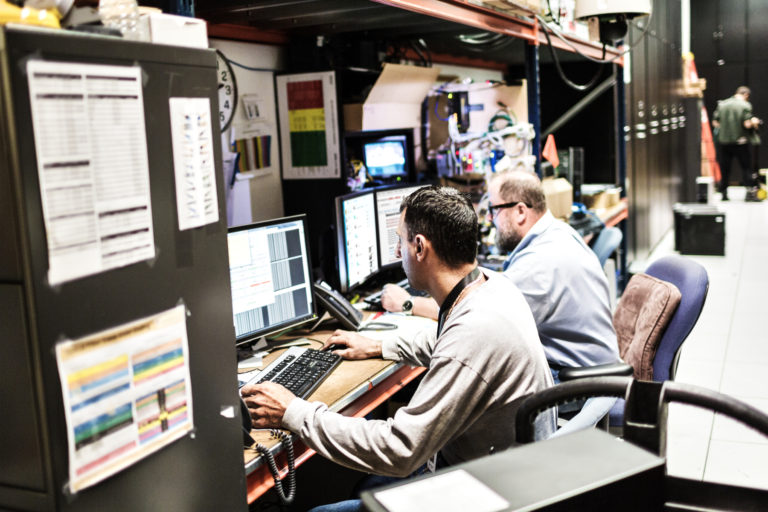Here’s what we need: build a data center that can support billions of unique server sessions per day. Also, let’s have it bring up personalized images, video, and other rich media content for hundreds of millions of people, simultaneously, the second they hit our servers. Oh, and don’t forget to make sure it can provide cloud infrastructure, advertising, commerce, and other services for millions of businesses. Sound good?
Twenty years ago, a request like this would have been a practical joke. Today, if you’re part of the networking team for a modern webscale company, it’s just another day at the office. In fact, the services that hyperscale networks like these provide have become so enmeshed in people’s day-to-day lives—Google searches, Facebook newsfeeds, cloud infrastructure, and business applications—they rarely stop to consider what it takes to provide them.
In my last blog, I mentioned some of the challenges involved in operating hyperscale data center infrastructures. That term is apt, as it encapsulates what’s so different about the technical challenge these networks need to solve: scale. Massive, overwhelming, hard-to-get-your-head-around scale. Let’s take a closer look at what it takes to keep up with modern webscale demands and how new innovations from Cisco can help you do it.
Scale Drives Everything

At the core of the hyperscale data center challenge is just a huge number of devices to monitor, manage, and maintain. A single data center can encompass a million servers, connected by tens of thousands of routers and switches. The only way to get a handle on all those devices is to radically simplify, which means radically automate. In our next blog, I’ll share how Cisco is helping webscalers do it. Now though, I’d like to focus on the other side of the scalability coin: capacity.
To deliver the web services that billions of people and millions of businesses depend on every day, hyperscale data centers must support:
- Huge numbers of concurrent users: Supporting many concurrent users has been one of the longstanding challenges in computing. (Network engineers were talking about the “C10k problem,” or the problem of handling 10,000 simultaneous connections, all the way back in 1999.) A company like Facebook supports more than 2 billion users. Even with just a fraction hitting Facebook’s data centers at any given time, serving all those requests demands a massive amount of computing power.
- Huge bandwidth requirements: A typical webscale company processes tens of petabytes of data per day (the equivalent of, say, several hundred billion file cabinets worth of information). Serving hundreds of millions of concurrent users—each of them a real-time rich media interaction.
- A huge amount of state to maintain: Every packet transmitted by every one of those users represents a new flow or network connection. This means the infrastructure is updating counters, tracking which packets have been sent and received, using up compute and memory. For a small number of network connections, it’s not all that taxing. For millions or billions, the resources needed to maintain and update all that state data become enormous.
- Increasingly rich experiences: Making all of this exponentially more challenging, the experiences that those millions of concurrent connections represent have become highly dynamic. Take a Facebook session. The second you log on, Facebook pulls up your personalized news feed, photos, video, advertising. A given connection may represent just a few bytes hitting Facebook servers, but it triggers a comparatively gigantic blast of data coming back at you.
Combine all these factors, and you get an explosion of traffic generated within hyperscale data centers just from servers communicating with each other. It’s why east-west traffic dominates these infrastructures. And it drives throughput and capacity requirements that most other companies never have to contemplate.
The Next Level in Data Center Capacity
To meet these challenges, webscale companies have had to continually push the envelope of what’s possible in data center networks. As Cisco continues to innovate to meet the changing needs of our customers, we’re bringing new capabilities to the table to enable unprecedented performance. Webscale companies can now take advantage of:
- Cisco Silicon One™: With the launch of our latest network processing unit (NPU) silicon architecture, Cisco is rewriting the rules for hyperscale data center networks. The Cisco Silicon One Q100 processor is the first routing silicon to exceed 10 Tbps with a single ASIC, with a roadmap to go beyond 50 Tbps. It delivers double the bandwidth and three times the number of packets per second of any other programmable silicon—without compromising on buffering, power efficiency, or scalability.
- Next-generation optics: New Cisco optical innovations help webscale companies embrace 400G network connectivity and beyond to power a new generation of rich digital experiences. Drawing on our state-of-the-art wafer-scale manufacturing and silicon photonics, you can deploy more reliable, higher-performing optics for networks that maintain 400G capacity across thousands of ports. Additionally, new Cisco digital signal processing (DSP) innovations will power optical networks that scale up to 800 Tbps, 1.6 Tbps, and beyond.
- High-capacity systems: Powered by Cisco Silicon One ASICs, new Cisco 8000 Series routers provide 400G-optimized platforms that scale from 10.8 Tbps up to 260 Tbps to meet the most demanding hyperscale infrastructure needs. Webscale companies also now have the option to use the Cisco 8000 Series (along with other new Cisco solutions for hyperscale data centers) as disaggregated hardware, with any software they choose. Microsoft, for example, is taking advantage of the Cisco 8000 Series’ support for Switch Abstraction Interface (SAI), a standards-based ASIC API that allows Microsoft to run their SONiC operating system on the Cisco 8000 series. (See more details here.) Other webscale companies are using Cisco IOS XR7, which provides a more modular, leaner, streamlined software stack for managing devices in hyperscale networks. The bottom line, you have the freedom to take advantage of next-generation Cisco capacity and throughput using whichever management and automation frameworks you choose. (More on that in the next blog.)
Just as important, these technologies represent new ways to take advantage of Cisco’s innovation. You can now mix and match components—processors, software, systems, optics—and build custom solutions perfectly suited to meet specialized needs in any part of a hyperscale infrastructure.
Scaling for the Future

The most amazing thing about the vast scales that webscale companies deal with: most of the time, people don’t even think about it. After all, that rich, personalized, near-instantaneous experience that hyperscale data centers provide to every user of Facebook (or Google, or any other major web service) has become table stakes. For users, that’s just what modern Internet services look like.
In the coming years, the demands on hyperscale infrastructures will be even greater. 5G will enable more users, more devices, more personalization, more immersive video and real-time experiences at ever-more incredible scales. At Cisco, we’re unleashing a new generation of networking capabilities to help make it all possible. And we can’t wait to see what comes next.

CONNECT WITH US